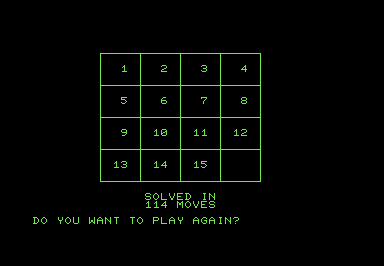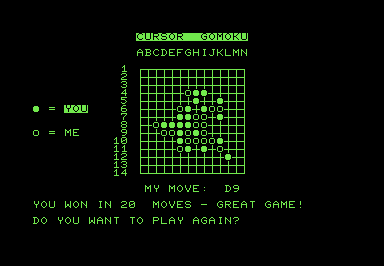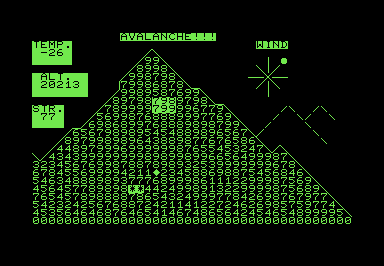CURSOR #15 – November/December 1979
“The response to our comments in the last issue about the ethics of copying
software has been very interesting. To summarize briefly, people do NOT want us to ‘protect’ programs in
such a way that they can't look at the source code, since many people study CURSOR programs as a way to
learn how to use the PET more effectively...Then there is also the fact that COMPUTE, the new 6502
magazine,
reprinted our article
in their second issue, and responded to our comments in a very helpful way.”
—Excerpted from Thank You, Issue #15

COVER
Author: Ken Morley and Glen Fisher
Original file name: COVER15!
PRG file: cover15.prg
This month's cover celebrates the 1979 Christmas season with a PETSCII Christmas tree, randomly-blinking lights (or possibly ornaments...round things, anyway) and the audio beeping out Deck the Halls, Good King Wenceslas, Jingle Bells, Rudolph the Red-Nosed Reindeer, and Silent Night. That's a lot of content to cram into 8K! Overall, this cover program makes effective use of the limited resources of the PET.
Pressing SPACE takes you to the
table of contents for the issue.

DUNGEON
Author: Brian Sawyer
Original file name: DUNGEON
PRG file: dungeon.prg
BASIC 4.0 version: dungeon40.prg
In DUNGEON, you wander around a randomly-generated dungeon fighting (or avoiding)
monsters and collecting gold. This random dungeon crawler predates the genre-defining game
Rogue, so I
guess rather than calling it "Roguelike", we should call it "proto-Roguelike".
You move around the dungeon with the numeric keypad, and you should be able to "magically"
walk through walls (with a small penalty to your hit points) if you press SHIFT
with any number. I've seen some reports from players that can't get the "walk through walls"
feature to work when using an emulator. The magic fails because of a bit of control-scheme
confusion that arises from the keyboard emulation.
On a full modern keyboard, there are two sets of number keys: one set along the top row, and
a second set on the numeric keypad. Early PET keyboards did not have numbers on the top keyboard
row—just punctuation marks—so while a modern keyboard treats SHIFT-4
and $ as the same key combination, the PET sees these as two different sets of keys.
From the PET's point of view, SHIFT-4 is only SHIFT-4 if it's the
correct 4. (Computers are very picky.) I've found that using keypad numbers
instead of the top row numbers fixes this problem. If you're using an emulator on a laptop with a
small keyboard, you may need to plug in an external keyboard in order to play DUNGEON
properly.
There's also a well-known bug in this program: it runs fine in BASIC 2.0 but on a machine with BASIC 4.0, the map will glitch because 4.0 changed the way strings are stored in memory. Robin of 8-Bit Show-and-Tell has uploaded an excellent video where he explains the issue and fixes the bug. I've provided the bug-fixed version above. Full credit to Robin for his sterling work.

FIFTEEN
Author: David Platton
Original file name: FIFTEEN
PRG file: fifteen.prg
FIFTEEN is a computer version of the sliding-tile puzzle known
as a 15 Puzzle.
The goal is to arrange the tiles in ascending numeric order. The controls in this one
are perfect and the puzzle plays really smoothly. From any starting position, an optimal
solution should require no more than 80 moves. Armed with that information, you have
something to aim for.
I did a bit of reading about the generation of 15 Puzzles and learned that half of all randomly-generated starting positions are impossible to solve. I also took a look at the BASIC listing for this program, and it appears that there is logic in place to prevent unsolvable puzzles from being generated (although I didn't trace through in any depth). I didn't encounter any puzzles I could not solve, and I played through quite a few, so I will unscientifically declare that it must be working.
It may be coincidence, but including a 15 puzzle in the fifteenth issue is a nice touch.

GOMOKU
Author: David Malmberg
Original file name: GOMOKU
PRG file: gomoku.prg
GOMOKU pits you against the PET in a game of
Gomoku in which you and your opponent
take turns placing stones on the board, trying to form an unbroken line of five stones.
You can choose whether the playstyle of the AI is aggressive, defensive, or balanced. I
found all three styles fairly easy to beat although when the PET plays defensively, you have
to plan ahead a little more. The PET requires some time to consider its moves. It feels
uncomfortably slow; I found myself resorting to warp mode in Vice when playtesting this one.

EVEREST
Author: Brian Sawyer
Original file name: EVEREST
PRG file: everest.prg
EVEREST has you climbing up the side of a mountain of numbers, where
higher numbers indicate a more difficult climb. Blizzards and avalanches complicate
your ascent. I have managed to
reach the summit,
so I can confirm that it is possible, although some luck is required. With a little practice, you should
be able to consistently score above 80 and earn the message YOUR CLIMBING WAS GREAT.

HAWAII!
Author: Ken Morely
Original file name: HAWAII!
PRG file: hawaii.prg
HAWAII! is an animated PETSCII movie that is actually a sequel to the
movie FLIGHT!
from CURSOR #12. According to the flyer, our two Canadian astronauts, having
returned from the moon, take a trip to Hawaii, where hijinks ensue.
This program does have sound but it's minimal, so if you don't hear anything for the first part of the animation, your audio is probably fine; you just have to be patient and wait for the bits with sound to come up.
This program has some minor glitches on old ROM PETs; corrections are printed in CURSOR #16.
